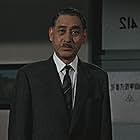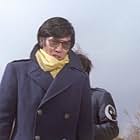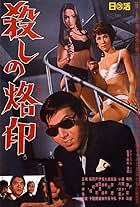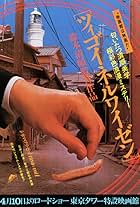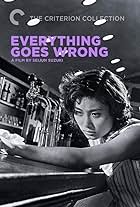After his gang disbands, a yakuza enforcer looks forward to life outside of organized crime but soon must become a drifter after his old rivals attempt to assassinate him.After his gang disbands, a yakuza enforcer looks forward to life outside of organized crime but soon must become a drifter after his old rivals attempt to assassinate him.After his gang disbands, a yakuza enforcer looks forward to life outside of organized crime but soon must become a drifter after his old rivals attempt to assassinate him.
Featured reviews
I will argue until my death that TOKYO DRIFTER is superior to BRANDED TO KILL, but that's for another time...
I am amazed every time I see this film that Suzuki could take such an obviously inferior product -- as Nikkatsu Studios was churning out at an obscene rate in those days, giving directors a script and saying "Shoot it fast and cheap so we can give you your next job" -- and turn it into one of the most beautiful and intriguing films I've ever seen.
Best plot ever? No. Easy to follow? Yes. Beautiful? Yes. And that theme...I could never forget that theme if I tried, even after my first viewing.
I'd ramble on about history and plot and so on, but so many others have, I'll just leave it at this: TOKYO DRIFTER makes me happy every time I see it.
I am amazed every time I see this film that Suzuki could take such an obviously inferior product -- as Nikkatsu Studios was churning out at an obscene rate in those days, giving directors a script and saying "Shoot it fast and cheap so we can give you your next job" -- and turn it into one of the most beautiful and intriguing films I've ever seen.
Best plot ever? No. Easy to follow? Yes. Beautiful? Yes. And that theme...I could never forget that theme if I tried, even after my first viewing.
I'd ramble on about history and plot and so on, but so many others have, I'll just leave it at this: TOKYO DRIFTER makes me happy every time I see it.
Having previously seen Branded to Kill on its Criterion release, and having found it to be utterly brilliant, I had to buy the Criterion release of Tokyo Drifter. It is not as good as Branded to Kill (heck, nothing can be), but it is still great. The color composition is particularly masterful. So what if the story is difficult to follow? It is still entertaining. I really wish more of Sezuki Seijun's films would be released by Criterion, or anyone else, for that matter. He's an extraordinarily interesting and gifted filmmaker who is very underappreciated in cinema history.
In my opinion, Tokyo Drifter is worth seeing, but comparing it to Branded to Kill is a bit like comparing apples and oranges.
Branded to Kill is eerie and nightmarishly weird--unforgettably, perhaps like a Hitchcock film or a dark film noire. Tokyo Drifter, on the other hand, is more "romantic." It is fun and chock full of mod 60s fashions and go-gos.
Both films are masterpieces of style. To me, Tokyo Drifter is worth seeing, but it has some silly moments. Somehow, I was left thinking of Woody Allen's What's Up Tiger Lilly and James Bond!
Branded to Kill is eerie and nightmarishly weird--unforgettably, perhaps like a Hitchcock film or a dark film noire. Tokyo Drifter, on the other hand, is more "romantic." It is fun and chock full of mod 60s fashions and go-gos.
Both films are masterpieces of style. To me, Tokyo Drifter is worth seeing, but it has some silly moments. Somehow, I was left thinking of Woody Allen's What's Up Tiger Lilly and James Bond!
If you are fed up by ordinary manufactured campiness, but still have normal levels of humor.. Which is to say if you find Austin Powers not only boring but trivial, you might check this out. It is high camp. It is ridiculous in ways that in other action films we readily accept: think the recent James Bonds. There is a joke product placement — for hair driers — that is really funny.
We have the ordinary sort of thing that qualifies: cheesy songs, goofy hero, posed action, jingly hipness. But we have a level of cheesiness that goes beyond the Tarrantino level, beyond the usual joke. The cinematography is one big joke, one that still works today because the big movies still use Vietnam era visual devices.
We have jokes on Bertralucci, Welles, Kurosawa. Leone of course. We have a couple stagings from Bergman even. It is not worth the effort to single out any Frenchman it seems, treating them with the contempt of wholesale dismissal.
Under ordinary circumstances, I would not recommend this because the usual level of the joke gets pretty tiring after 20-30 minutes. But the cinematic jokes and references keep coming, as though there were a catalogue (like we are told the Coen brothers keep). The blatant vacancy of the visuals is pretty damning.
Ted's Evaluation -- 2 of 3: Has some interesting elements.
We have the ordinary sort of thing that qualifies: cheesy songs, goofy hero, posed action, jingly hipness. But we have a level of cheesiness that goes beyond the Tarrantino level, beyond the usual joke. The cinematography is one big joke, one that still works today because the big movies still use Vietnam era visual devices.
We have jokes on Bertralucci, Welles, Kurosawa. Leone of course. We have a couple stagings from Bergman even. It is not worth the effort to single out any Frenchman it seems, treating them with the contempt of wholesale dismissal.
Under ordinary circumstances, I would not recommend this because the usual level of the joke gets pretty tiring after 20-30 minutes. But the cinematic jokes and references keep coming, as though there were a catalogue (like we are told the Coen brothers keep). The blatant vacancy of the visuals is pretty damning.
Ted's Evaluation -- 2 of 3: Has some interesting elements.
Unless you have been blessed to track down the films of Suzuki Seijun, you will never, ever, have seen anything like this before. It has a plot - it is a gangster film - a hero, his girl and villains. There are betrayals and gunfights. You still won't have seen anything like this before. Imagine A BOUT DE SOUFFLE, shot in the style of UNE FEMME EST UNE FEMME, with a mixture of Leone, Welles, Melville, THE AVENGERS and Fuller's HOUSE OF BAMBOO. Not even close.
The basic plot concerns the title hero, a gangster trying to go straight. His boss and father-figure (this is a very Oedipal film, but the concept, with its many variations, is stretched to absurd breaking point), also a former gangster, is being pushed around by some extraordinarily attired hoods. The hero has a girl who sings big Michel Legrand-type numbers in a huge, blazingly colourful art deco/Busby Berkeley/Jean Cocteau-type nightclub. Because the hero is a maverick, he lies low for a while (i.e. drifts), but is followed by a hitman. All converges in a fairly predictable fashion.
To appropriate the ad, Plot is Nothing, Style is Everything. If a studio with big resources is, as Welles claimed, a 'toy set', then Seijun is the class freak. The monochrome gangster world is blown apart by shocks of colour, be they dazzling primary hues, or deliberately effete pastels. This serves to upturn the black and white ideology of the gangster genre. The men are all snarling and macho, but the hero sings and whistles, like the Duke's singing cowboy; the lead villain wears loud red shirts and sports a ridiculous moustache. There is even room in the plot for a gag about hairdryers.
Like in Godard, the crucial plot elements are roundly mocked; the seemingly major event of the hero being captured by and subsequently evading the police is as if filmed by an inept child. The group violence scenes are messy, like brawls at a children's party. There is even a bar-room brawl in a Western saloon in a Japanese gangster movie.
Mirroring Melville's heros, the hero aspires to aloof self-sufficiency, but he is constantly undermined by the film. Whole chunks of story don't make sense. The vertiginous editing is like the maniacal string-pulling of a puppeteer ,and there is a strong Brechtian feel to the film, with frequent breaks for cheesy song; impossible sets; unmotivated lighting; some of the most bizarre and beautiful camera movements in film.
All this stylistic bravura could be monotonous if it wasn't grounded intellectually and emotionally. There are some really beautiful oases of grace amid the violent mayhem. The film is a firm attack on the assumptions of genre, conformity, sterile repetition, linked to conformity in Japanese society at large, and big business in particular. Like 50s melodramas, the colour schemes, lighting and composition reflect the state of mind of the characters. The lengthy snow sequence is worthy of Joyce's 'The Dead'.
When it comes to Japanese cinema, I know we're all supposed to bow down to Kurosawa and Ozu, but I'll take the absolutely hatstand Seijun anyday. Breathtaking genius.
The basic plot concerns the title hero, a gangster trying to go straight. His boss and father-figure (this is a very Oedipal film, but the concept, with its many variations, is stretched to absurd breaking point), also a former gangster, is being pushed around by some extraordinarily attired hoods. The hero has a girl who sings big Michel Legrand-type numbers in a huge, blazingly colourful art deco/Busby Berkeley/Jean Cocteau-type nightclub. Because the hero is a maverick, he lies low for a while (i.e. drifts), but is followed by a hitman. All converges in a fairly predictable fashion.
To appropriate the ad, Plot is Nothing, Style is Everything. If a studio with big resources is, as Welles claimed, a 'toy set', then Seijun is the class freak. The monochrome gangster world is blown apart by shocks of colour, be they dazzling primary hues, or deliberately effete pastels. This serves to upturn the black and white ideology of the gangster genre. The men are all snarling and macho, but the hero sings and whistles, like the Duke's singing cowboy; the lead villain wears loud red shirts and sports a ridiculous moustache. There is even room in the plot for a gag about hairdryers.
Like in Godard, the crucial plot elements are roundly mocked; the seemingly major event of the hero being captured by and subsequently evading the police is as if filmed by an inept child. The group violence scenes are messy, like brawls at a children's party. There is even a bar-room brawl in a Western saloon in a Japanese gangster movie.
Mirroring Melville's heros, the hero aspires to aloof self-sufficiency, but he is constantly undermined by the film. Whole chunks of story don't make sense. The vertiginous editing is like the maniacal string-pulling of a puppeteer ,and there is a strong Brechtian feel to the film, with frequent breaks for cheesy song; impossible sets; unmotivated lighting; some of the most bizarre and beautiful camera movements in film.
All this stylistic bravura could be monotonous if it wasn't grounded intellectually and emotionally. There are some really beautiful oases of grace amid the violent mayhem. The film is a firm attack on the assumptions of genre, conformity, sterile repetition, linked to conformity in Japanese society at large, and big business in particular. Like 50s melodramas, the colour schemes, lighting and composition reflect the state of mind of the characters. The lengthy snow sequence is worthy of Joyce's 'The Dead'.
When it comes to Japanese cinema, I know we're all supposed to bow down to Kurosawa and Ozu, but I'll take the absolutely hatstand Seijun anyday. Breathtaking genius.
Did you know
- TriviaWas shot and edited in 28 days.
- Quotes
Tetsuya 'Phoenix Tetsu' Hondo: A drifter needs no woman.
- ConnectionsFeatured in Seijun Suzuki | TCM (2013)
- How long is Tokyo Drifter?Powered by Alexa
Details
- Release date
- Country of origin
- Languages
- Also known as
- Abrechnung in Tokio
- Filming locations
- Production company
- See more company credits at IMDbPro
Box office
- Gross worldwide
- $755
- Runtime1 hour 22 minutes
- Color
- Sound mix
- Aspect ratio
- 2.35 : 1
Contribute to this page
Suggest an edit or add missing content














